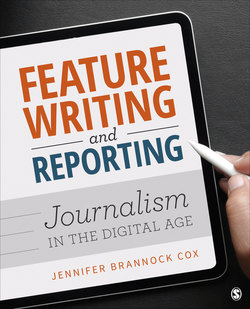Читать книгу Feature Writing and Reporting - Jennifer Brannock Cox - Страница 32
На сайте Литреса книга снята с продажи.
Tearing Down the Gate
ОглавлениеMedia scholars have traditionally identified journalists as gatekeepers who make decisions about what information reaches the public and how it is presented and distributed. As gatekeepers, journalists generally decide what events are newsworthy based on one of three factors:
1 Timeliness of the news event. Is something of impact happening now in the news organization’s coverage area?
2 Goals of policymakers. What topics are important to official sources who pass along information to journalists?
3 Opinions of news producers. What topics are resonating with reporters, editors and managers at the news organization?
Journalists exercise control over the news their audiences get and have often believed they know what is best when it comes to what readers should know. When reading a newspaper or magazine, it is relatively easy to control the flow of information, as audiences have to content themselves with only the news that is right in front of them. Journalists indicate what they believe is most important, putting it on the front pages of each newspaper section or magazine and ordering the sections according to what they believe to be most newsworthy, and print readers tend to follow along, reading linearly, from top to bottom, left to right and front to back.
Consuming news online is a more nonlinear process. Readers not only have the ability to click around randomly within a news website; they can go to any one of thousands of sources of information to seek the news they want. If readers want news about the latest celebrity coupling, they don’t have to sift through the front pages of a newspaper or more in-depth stories in a magazine—they can simply visit niche websites geared toward celebrity gossip or use a search engine to find news about a particular couple.
News organizations have to fight harder for readers’ attention online, causing them to rethink how news is defined. Now journalists must pay closer attention to a fourth factor in determining what to write about:
4.Public opinion. What topics are trending with audiences right now?
Taking trending topics into account when writing and reporting features can push journalists to produce stories that truly impact readers. For example, stories about product recalls or health warnings circulate fast online, alerting large audiences to potential danger. Reporters know what stories are trending thanks to online tracking metrics. Many social media sites and search engines have lists of trending topics reporters can pull from. Reporters can also tell what stories are trending in their own publications using software such as Chartbeat.
Chartbeat is a tool allowing media organizations to track and better understand audience trends, helping them see which stories, headlines, photos and other multimedia features engage users most.
Chartbeat.com
Trending topics grant reporters insight into readers’ interests, but they must be careful not to get distracted from significant news. In 2014, news organizations across the U.S. published articles clarifying that actress Betty White was not dead after satirical news site Empire News wrote a misleading headline titled “Betty White Dyes Peacefully in Her Los Angeles Home.” The story revealed that the actress colors, or “dyes,” her hair, but fans circulated the article widely on social media, believing the actress to be dead. As a result, news organizations published brief clarifications stating that White was alive in hopes of cashing in on the trending topic. For example, The Washington Post followed up the next day with the headline “Betty White Is Not Dead.”11
